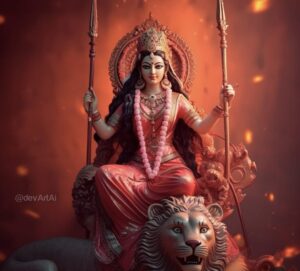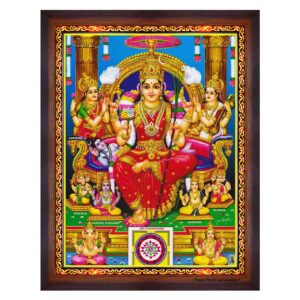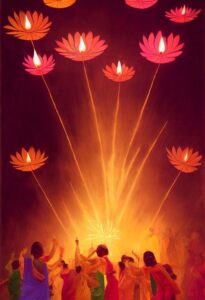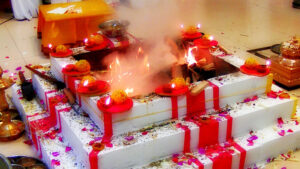In the grand tapestry of India’s spiritual traditions, the festival of Navaratri shines as a radiant gem, celebrating the embodiment of Devi’s divine energy. At its heart, Navaratri is a time of invoking blessings and rectifying life’s imbalances and there’s no better way to channel this cosmic energy than through the sacred ritual of Chandi Homa.
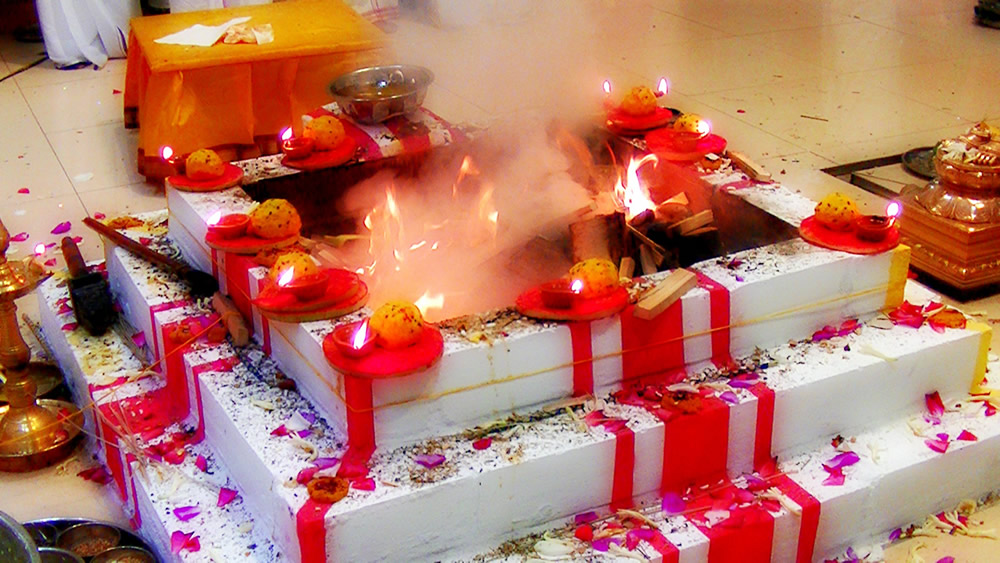
Chandi Homa takes center stage during Navaratri, a profoundly sacred ceremony performed in temples across India. It is an act of devotion, a bridge between the earthly and the divine, a way to connect with the ultimate feminine power, Devi. The faithful believe that by participating in this sacred rite, they can dispel negativity and find harmony within their lives.
The essence of Chandi Homa lies in the recitation of verses from Saptashati which contains 13 chapters dedicated to Mahakali, Mahalakshmia and Mahasaraswati which comes to a total of 700 shlokas which is considered the main part of the puja. These verses invoke Chandi Devi herself. As the mantras echo through the sacred space, it is believed that Chandi Devi descends into the very heart of the seeker, filling them with her divine presence, grace and power.
As the fire dances in the homa kunda, symbolic offerings are made to the goddess. These tokens of devotion and surrender are more than mere items; they are vessels of faith. Mantras rise like fragrant incense, inviting the blessings of Chandi Devi into the lives of those who offer them.
Chandi Devi’s legend is one of fiery determination, a story of her unrelenting battle against the demon Mahishasura. Even in her victory, her wrath continued to blaze. To soothe this divine anger, Lord Shiva himself descends. Following the recitation of Chandi’s verses, the pandits perform the Namakam Chamakam, inviting Lord Shiva’s presence and his soothing touch.
As the Chandi Homa reaches its crescendo, the purnahuti takes place. A profound offering, it is a gesture of gratitude and devotion to the goddess. Sarees, gold, ragi coins and more are presented as a token of their heartfelt devotion.
Intricately woven into this sacred ceremony is the use of sacred ashes, each particle brimming with divine power. These ashes, when applied as a bindi on the devotees’ foreheads, bestow them with Devi’s blessings and protection.
Though the stories of our traditions may have various retellings, they share a common thread — a call for discipline, unwavering devotion and a connection with our inner selves. This journey of spiritual exploration has been deeply enriching and I extend my heartfelt gratitude to all those who have been my guiding stars on this path.
I have taken the liberty to use images from Instagram, and I extend my heartfelt appreciation to the talented artists and dedicated pages for sharing their exceptional artwork and content. In an effort to duly acknowledge their creative contributions, I have diligently displayed the names of their pages directly on the images. I wish to emphasize that my intention was never to infringe upon copyrights or misuse these visuals, but rather to pay homage to the remarkable work of these creators. My deepest gratitude goes out to all those who have poured their passion and artistry into this shared tapestry of devotion.
My profound gratitude extends to the learned pandits who generously imparted their wisdom and knowledge.
